What's Happening?
On September 7, 2025, a total lunar eclipse occurred, visible across most of the Eastern Hemisphere. Known as a 'Blood Moon,' the event was characterized by the moon turning an orange-red color due to the alignment of the Sun, Earth, and Moon. Astronauts aboard the International Space Station captured images of the eclipse, showcasing the moon's coppery red appearance during the partial phase. The total eclipse lasted one hour and 22 minutes, marking the longest duration since November 2022. The phenomenon was visible to an estimated 85 percent of the planet's population, including regions in Europe, Africa, Asia, and Australia.
Why It's Important?
The Blood Moon offers a unique opportunity for scientific observation and public engagement with astronomy. The event highlights the interaction between Earth's atmosphere and sunlight, providing insights into atmospheric conditions. For NASA and the scientific community, such eclipses are valuable for studying celestial mechanics and atmospheric effects. The widespread visibility of the eclipse also fosters global interest in space phenomena, encouraging educational activities and public participation in astronomy.
What's Next?
The next total lunar eclipse is scheduled for March 3, 2026, and will be visible from the Americas, East Asia, Australia, and the Pacific. This upcoming event will provide another opportunity for scientific study and public engagement. NASA and other space agencies may plan further observations and outreach activities to maximize the educational impact of the eclipse.












